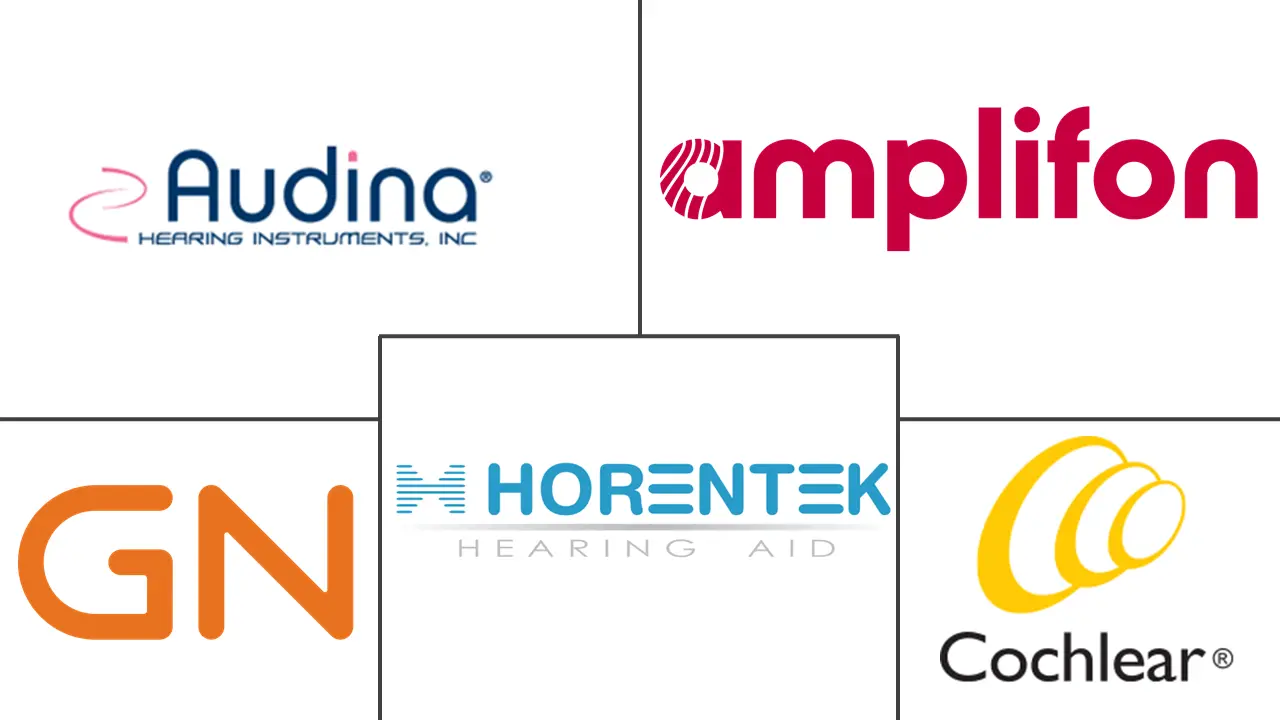Hearing Aids Market Size and Share
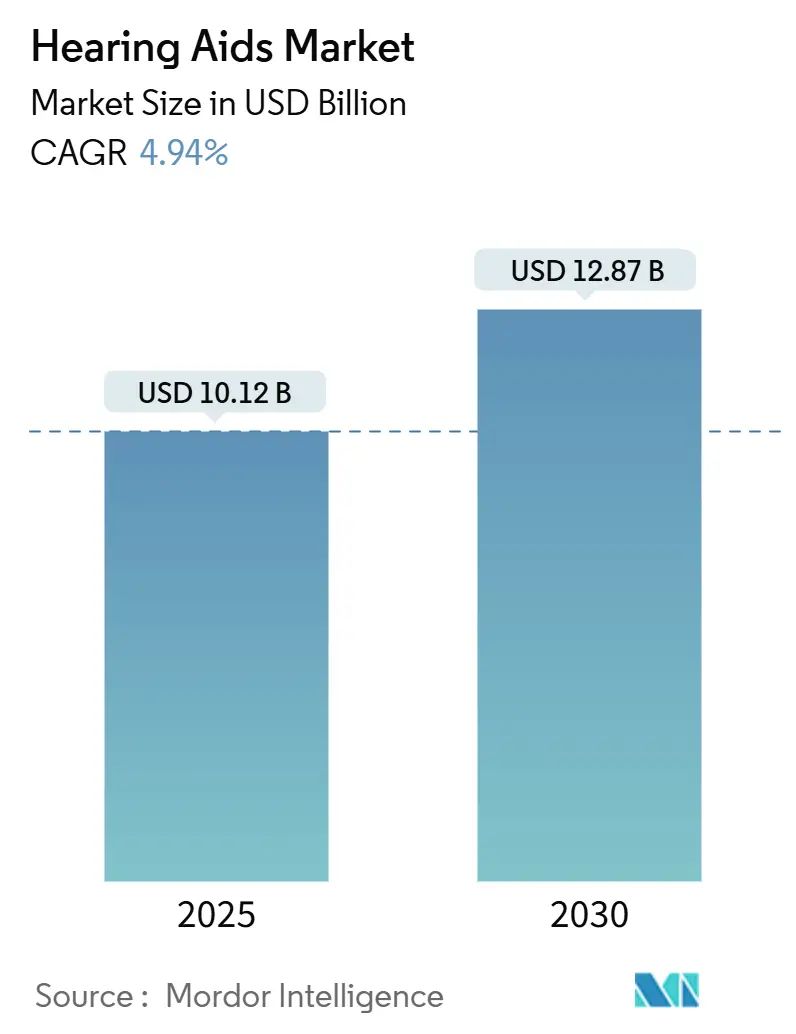
Hearing Aids Market Analysis by Mordor Intelligence
The hearing aids market stands at USD 10.12 billion in 2025 and is on track to reach USD 12.87 billion by 2030, rising at a 4.94% CAGR. Direct-to-consumer access, artificial intelligence sound-processing advances, and the entry of consumer-electronics brands are together redrawing competitive rules. Premium manufacturers now position rechargeable, AI-enabled models as wellness wearables that integrate with smartphones and health platforms, a strategy that both supports higher average selling prices and broadens appeal to tech-savvy users. Meanwhile, U.S. OTC legalization compresses traditional audiology margins yet expands the addressable base among consumers with mild-to-moderate loss. Demographic pressure from longer life expectancy and rising noise exposure sustains a steady replacement cycle and opens opportunities for subscription and service-based revenue models.
Key Report Takeaways
- By product type, Behind-the-Ear solutions led with 45.35% of hearing aids market share in 2024, while Receiver-in-Canal devices are poised for the fastest 7.25% CAGR through 2030.
- By technology, digital platforms held 85.53% of the hearing aids market size in 2024, and AI-enabled variants are advancing at 10.85% CAGR.
- By patient type, adults accounted for 73.82% of demand in 2024, whereas pediatric fittings are forecast to climb at 8.61% CAGR.
- By type of hearing loss, sensorineural held 85.62% revenue share in 2024, while mixed segment is forecast to grow at an 7.22% CAGR.
- By device design, disposable battery led with 54.82% of market share in 2024; rechargeable lithium-ion is advancing at a 10.21% CAGR to 2030.
- By distribution channel, prescription channels retained 65.82% share in 2024 but OTC retail is expanding at 9.21% CAGR.
- By geography, North America commanded 38.82% revenue in 2024 and Asia-Pacific is the fastest-growing geography at 8.21% CAGR.
Global Hearing Aids Market Trends and Insights
Drivers Impact Analysis
| Driver | (~) % Impact on CAGR Forecast | Geographic Relevance | Impact Timeline |
|---|---|---|---|
| Rising Burden Of Hearing Loss | +1.2% | Global, with concentration in aging populations | Long term (≥ 4 years) |
| Aging Population & Prolonged Life-Expectancy | +1.0% | North America, Europe, Japan | Long term (≥ 4 years) |
| Technological Advances (Digital, AI, Connectivity) | +0.8% | Global, led by developed markets | Medium term (2-4 years) |
| OTC Legalization & Broader Access | +0.6% | North America, with spillover to other regions | Short term (≤ 2 years) |
| Smart-Wearable Convergence: Health Monitoring Biosensors | +0.4% | North America, Europe, Asia-Pacific urban centers | Medium term (2-4 years) |
| Hearables Ecosystem Pull From Consumer-Audio Brands | +0.3% | Global, consumer electronics penetration markets | Short term (≤ 2 years) |
| Source: Mordor Intelligence | |||
Rising Burden of Hearing Loss
Global prevalence climbed to 430 million people in 2024 and is projected to touch 700 million by 2050, placing sustained upward pressure on demand. Urban noise exposure, ototoxic medication use and chronic diseases such as diabetes amplify lifetime risk, reinforcing the importance of preventive screening and early amplification. Governments now integrate hearing health into healthy-aging policy frameworks, enabling partial reimbursement and tax credits that foster device uptake. Manufacturers respond with value-tier digital models priced below USD 1,000 to reach first-time users in emerging markets. The strategy supports volume expansion without fully cannibalizing premium lines and therefore lifts overall revenue mix.
Aging Population and Prolonged Life Expectancy
Japan, Italy and Germany each report median ages above 45 years, and individuals are living longer with higher expectations for active social participation. Clinical data linking untreated loss to cognitive decline has sparked physician referrals and insurer interest in preventive amplification. Medicare Advantage plans in the United States now bundle hearing benefits in 97% of offerings, creating a reimbursement runway that underpins steady unit growth. Device makers counter longer life spans with more durable housings, moisture protection and software updates that keep older hardware compatible with new phones. These adaptations lengthen product life cycles yet entice upgrades through iterative AI firmware releases.
Technological Advances in Digital, AI and Connectivity
Phonak’s DEEPSONIC chip executes trillions of operations per second, improving speech-in-noise performance by 10 dB and cutting listening effort by 45%[1]Sonova, “Phonak elevates sound quality with real-time AI,” sonova.com. GN’s ReSound Vivia and Oticon Intent extend the arms race with on-device neural networks and multi-sensor fusion that infer user intent from head and body movement. Full Bluetooth LE Audio support plus Auracast broadcast reception makes hearing aids integral to public-venue sound systems, unlocking new use cases in theaters, airports and lecture halls. The result is stronger differentiation at the top end, higher attach rates for cloud-based fitting services and growing subscription revenue from remote firmware upgrades.
OTC Legalization and Broader Access
The United States finalized the OTC category in late 2023, triggering the launch of pharmacy and online devices priced between USD 200 and 1,500. Early entrants such as Eargo and Lexie now use cloud-audiometry apps for self-fitting, though return rates remain higher than in the prescription channel. Big-box retailers and pharmacy chains leverage national footprints to supply affordable starter devices while upselling batteries and accessories. Traditional brands hedge by partnering with mass retailers under white-label arrangements, preserving margin and service revenue through in-store kiosks and remote audiologist support. Regulations in Canada, Australia and parts of Europe are under review, suggesting spill-over liberalization that could add incremental units over the next two years.
Restraints Impact Analysis
| Restraint | (~) % Impact on CAGR Forecast | Geographic Relevance | Impact Timeline |
|---|---|---|---|
| High Device Cost & Presence Of Cheaper Substitutes | -0.7% | Global, acute in emerging markets | Medium term (2-4 years) |
| Patchy Insurance / Reimbursement Coverage | -0.5% | Global, varying by healthcare system | Long term (≥ 4 years) |
| Social Stigma & Low Adoption In Emerging Markets | -0.3% | Emerging markets, rural areas | Long term (≥ 4 years) |
| Lithium-Ion Supply-Chain Volatility For Rechargeables | -0.2% | Global manufacturing, Asia-Pacific supply base | Short term (≤ 2 years) |
| Source: Mordor Intelligence | |||
High Device Cost and Cheaper Substitutes
Traditional prescription pairs retail between USD 2,400 and 6,150, a price band that leaves 85% of adults with hearing difficulty untreated. OTC and personal sound amplification products offer lower-cost entry but often underperform in complex listening environments, leading to early abandonment and negative word-of-mouth. As smart earbuds such as Apple’s AirPods Pro 2 receive FDA clearance for hearing aid functionality at USD 250, pricing pressure cascades through mid-tier segments. Manufacturers mitigate erosion by bundling tele-audiology, extended warranties and software upgrades, reframing the sale as an ongoing service rather than a one-time purchase. Emerging market governments explore bulk tenders and local assembly incentives to curb import costs, but semiconductor and lithium-ion inputs limit deep discounts.
Patchy Insurance and Reimbursement Coverage
Original Medicare in the United States still excludes standard hearing aids, forcing many retirees toward private pay or Medicare Advantage, where benefit generosity varies by plan and county[2]Centers for Medicare & Medicaid Services, “Audiology Services,” cms.gov. European single-payer systems reimburse up to 100% of basic digital models, yet premium receivers often require co-pays that deter upgrades. In low- and middle-income countries, national health insurance either excludes hearing aids or limits reimbursement to children, shrinking adult penetration. Veterans Affairs bulk purchasing lowers prices but creates brand lock-in, complicating post-service refitting when veterans relocate outside the VA network. Fragmented funding dampens adoption among price-sensitive cohorts despite clear clinical benefit.
Segment Analysis
By Product Type: RIC Acceleration Challenges BTE Leadership
Behind-the-Ear models held 45.35% of hearing aids market share in 2024 because larger casings accommodate multi-core processors, telecoils and high-capacity batteries that extend daily runtime. The form factor also simplifies pediatric fittings due to replaceable ear hooks that adjust with growth. Receiver-in-Canal devices are set to log a 7.25% CAGR through 2030, propelled by slimmer profiles, Bluetooth streaming and color palettes that blend with hair and skin. Users favor the discreet look, while audiologists appreciate easier receiver replacement during maintenance. The hearing aids market sees complementary momentum in In-the-Ear and Completely-in-Canal segments among consumers seeking invisible solutions, though acoustic feedback control remains a design challenge in tiny shells. Cochlear and bone-anchored implants together target severe loss and are projected to reach USD 940.1 million by 2030, corresponding to 9.3% of hearing aids market size within surgical indications.
Innovation revolves around energy management and universal connectivity. Signia’s Pure Charge&Go BCT IX combines Bluetooth Classic and LE Audio to ensure compatibility with older smartphones while future-proofing for Auracast broadcasts. The model secures 36 hours of operation on a single charge and implements adaptive beamforming that prioritizes speech from the wearer’s focal direction. Competitive products integrate MEMS inertial sensors to trigger automatic program switches when users walk, drive or enter a crowded venue. These enhancements reinforce the transition from single-purpose amplifiers to multifunctional wearables, widening the addressable audience inside the hearing aids market.
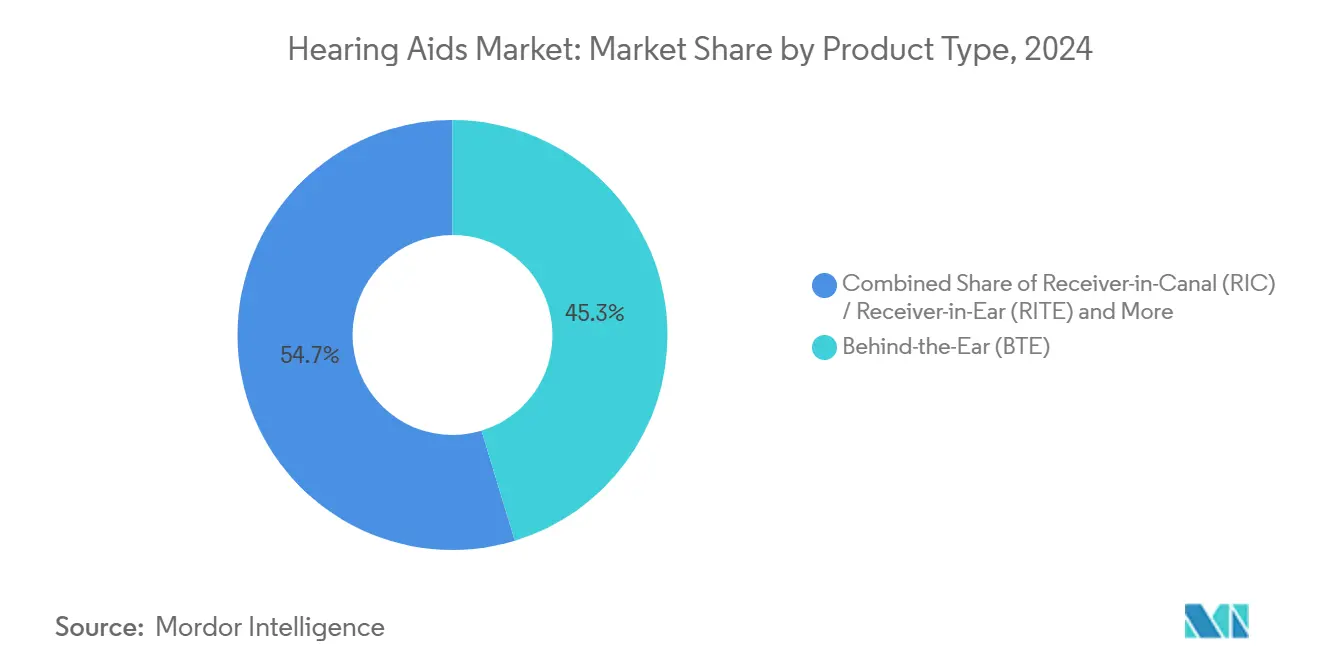
Note: Segment shares of all individual segments available upon report purchase
By Technology: AI Upshifts Digital Dominance
Digital architecture already commands 85.53% of 2024 revenue, relegating analog circuits to niche, ultra-low-cost propositions. Layering artificial intelligence onto established DSP creates a premium stratum forecast to expand at a 10.85% CAGR, lifting the overall hearing aids market trajectory. Phonak’s Infinio platform integrates a neural accelerator that cuts latency to under 10 milliseconds and delivers 10 dB better speech-in-noise ratio. GN’s ReSound Vivia extends machine learning to wind noise prediction, while Oticon’s Intent uses head-motion sensors to infer listening intent. Cloud-connected apps push real-time language translation, fall detection and heart-rate trends to smartphones, positioning hearing aids as broader wellness nodes.
Analog offerings persist where reimbursement ceilings or consumer budgets limit digital upgrades, especially in some Latin American and African markets. However, declining microcontroller costs and open-source firmware ecosystems narrow the price delta, and many entry-level products now ship with basic AI noise suppression. As a result, the hearing aids market is likely to reach near-total digital saturation before the end of the decade. The spread of LE Audio further democratizes connectivity, allowing multi-stream sharing in classrooms and conference rooms without specialized infrastructure.
By Type of Hearing Loss: Sensorineural Core With Mixed-Case Upside
Sensorineural loss applications represented 85.62% of 2024 unit volume, reflecting widespread age-related and noise-induced cochlear damage across industrialized economies. Devices for conductive and mixed losses gain relevance as diagnostic imaging and tympanometry improve differential assessment, enabling audiologists to prescribe combined acoustic and bone-conduction solutions. Mixed loss fittings are projected to rise at 7.22% CAGR, benefiting from crossover products that merge air and bone pathways in a single shell. Research from Wake Forest University demonstrates micro-epidermal actuators that bypass obstructions, signalling future non-surgical options[3]ScienceDaily, “Study highlights noninvasive hearing aid,” sciencedaily.com. Such breakthroughs could gradually migrate from clinical trials to commercial lines, expanding the hearing aids market size across complex pathologies.
Manufacturers diversify transducer arrays to address asymmetrical profiles, introducing programmable CROS and BiCROS modes that route sound from the poorer ear to the better cochlea without occlusion. Algorithmic advances now compensate for head shadow and localization deficits, improving spatial awareness for unilateral users. Pediatric protocols increasingly screen for auditory neuropathy and hidden hearing loss, giving rise to early bilateral fittings that prevent language development delays. These dynamics support a robust pipeline in accessories and software, from remote microphone companions to school-age classroom transmitters.
By Patient Type: Adult Steadiness Versus Pediatric Momentum
Adults made up 73.82% of 2024 purchasers, driven by workplace communication requirements and the clinical link between hearing care and cognitive health maintenance. The ACHIEVE study found that amplification reduces cognitive decline risk, motivating physicians to recommend screenings during routine check-ups. Older adults increasingly select rechargeable models to avoid dexterity challenges posed by tiny zinc-air batteries. Meanwhile, pediatric fittings are expanding at 8.61% CAGR through earlier newborn screening and relaxed cochlear implant candidacy criteria.
Children require tamper-proof battery doors, water-resistant housings and brightly colored shells for compliance monitoring. Frequent earmold replacements accommodate growth, creating a recurring revenue stream for audiology clinics inside the hearing aids market. Educational accommodations such as FM systems and classroom soundfield amplification also boost accessory sales. Non-profit programs and public tenders foster access in low-income regions, though global chip shortages have periodically delayed pediatric device deliveries, highlighting the need for diversified supply chains.
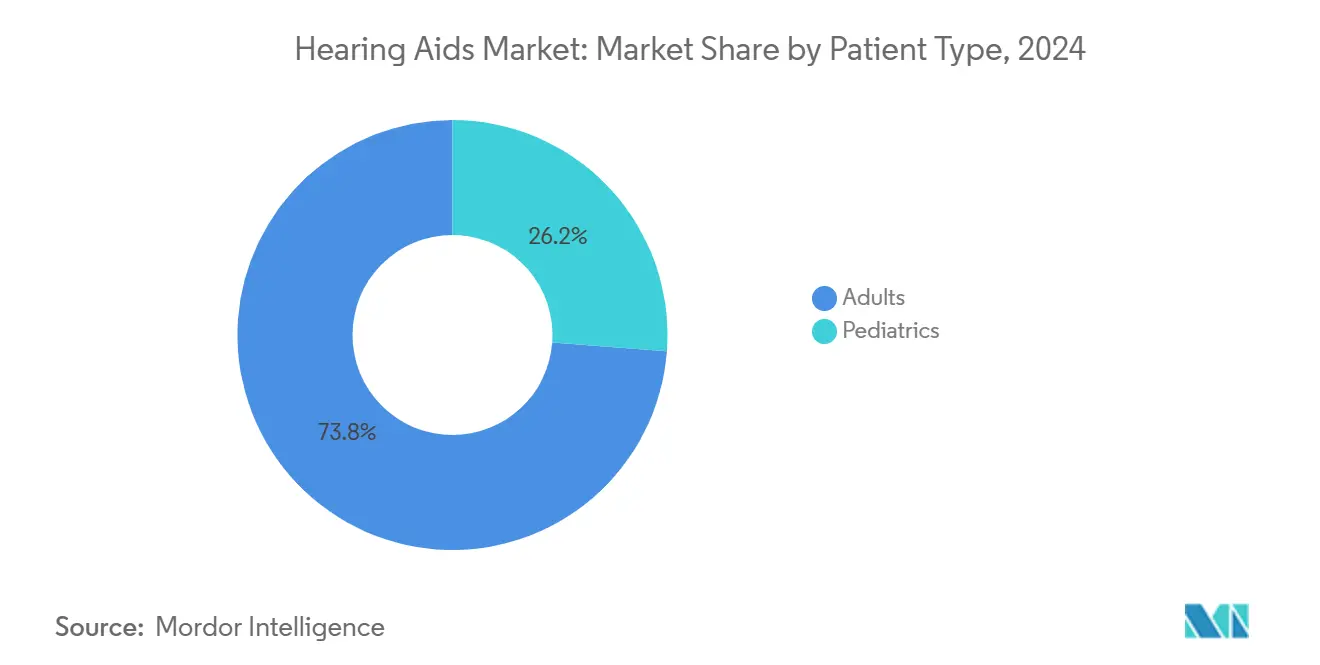
Note: Segment shares of all individual segments available upon report purchase
By Distribution Channel: Clinical Prescriptions Confront Omnichannel Models
Prescription routes commanded 65.82% of sales in 2024 on the strength of audiologist expertise, real-ear measurements and follow-up services that optimize long-term outcomes. The regulatory opening for OTC devices is driving a 9.21% CAGR in retail pharmacies and e-commerce storefronts. Hybrid tele-audiology platforms weave together online hearing tests, curbside device pickup and video counseling, blending convenience with clinical oversight. The Interstate Compact for Audiologists aims to expand cross-state practice, facilitating tele-fitting for rural populations.
Consumer electronics firms leverage vast app ecosystems to offer firmware updates and data visualization dashboards unavailable on many legacy prescription models. In response, incumbents launch subscription bundles that include loss-replacement insurance, unlimited remote tuning and yearly firmware upgrades. Price transparency rises as online marketplaces list feature-by-feature comparisons, pressuring margins yet enlarging the total hearing aids market pie by engaging first-time buyers who once ignored professional channels.
By Device Design: Rechargeable Uptake Re-shapes User Expectations
Disposable zinc-air batteries retained 54.82% share in 2024, but rechargeable lithium-ion formats grew 10.21% and already account for 80% of U.S. sales. Starkey’s Genesis AI delivers 51 hours of continuous use, addressing anxieties over charge longevity. Signia’s rechargeable completely-in-canal model extends the technology to the smallest form factor, broadening adoption among image-conscious users. Wireless charging docks and pocket power banks convert battery life into a lifestyle differentiator, mirroring smartphone accessory ecosystems.
R&D labs experiment with piezoelectric and thermoelectric harvesters that convert jaw motion, body heat and ambient light into trickle energy, aiming for fully self-powered hearing aids over the long term. While commercial launch remains distant, proof-of-concept prototypes showcase feasibility. Supply-chain resilience enters the strategic agenda as geopolitical tension tightens lithium availability; manufacturers now allocate 3-5% of revenue to supply-chain services for battery and semiconductor continuity. These steps help stabilize production volumes and protect the hearing aids market from component shocks.
Geography Analysis
North America contributed 38.82% of global revenue in 2024, supported by Medicare Advantage coverage, Veterans Affairs volume and tech-forward consumers who embrace Apple’s FDA-cleared AirPods Pro 2 hearing aid function. High household income and insurance penetration enable premium ASPs, especially for AI-based receivers with health-monitoring add-ons. Canada’s single-payer system reimburses basic models, while private plans cover upgrades, sustaining a balanced public-private mix. Mexico records rising uptake through public tender programs and mid-tier private clinics targeting urban middle-class professionals.
Europe maintains a solid presence through universal coverage and Medical Device Regulation harmonization. Germany leads unit volume under statutory health insurance that subsidizes entry-level digital aids, yet consumers often co-pay for rechargeable or Bluetooth-enabled options. The United Kingdom faces dual regulatory pathways post-Brexit, requiring CE and UKCA marks that raise compliance costs. Italy and Spain continue to modernize aging audiology centers with tele-fitting tools, while France expands occupational hearing conservation, creating upstream screening demand.
Asia-Pacific is the fastest-growing hub at 8.21% CAGR, led by Japan where fashionable designs overcome stigma and benefit from strong yen purchasing power. China’s Healthy Elderly 2030 plan reimburses digital aids for low-income seniors, expanding public funding. India sees private chain hospitals entering tier-2 cities with bundled ENT and audiology services, although GST adds cost pressure. South Korea pioneers 5G-enabled cloud fitting, and Australia broadens its Hearing Services Program to cover remote indigenous communities. Southeast Asia benefits from rising middle-class incomes and corporate insurance packages that include hearing benefits.
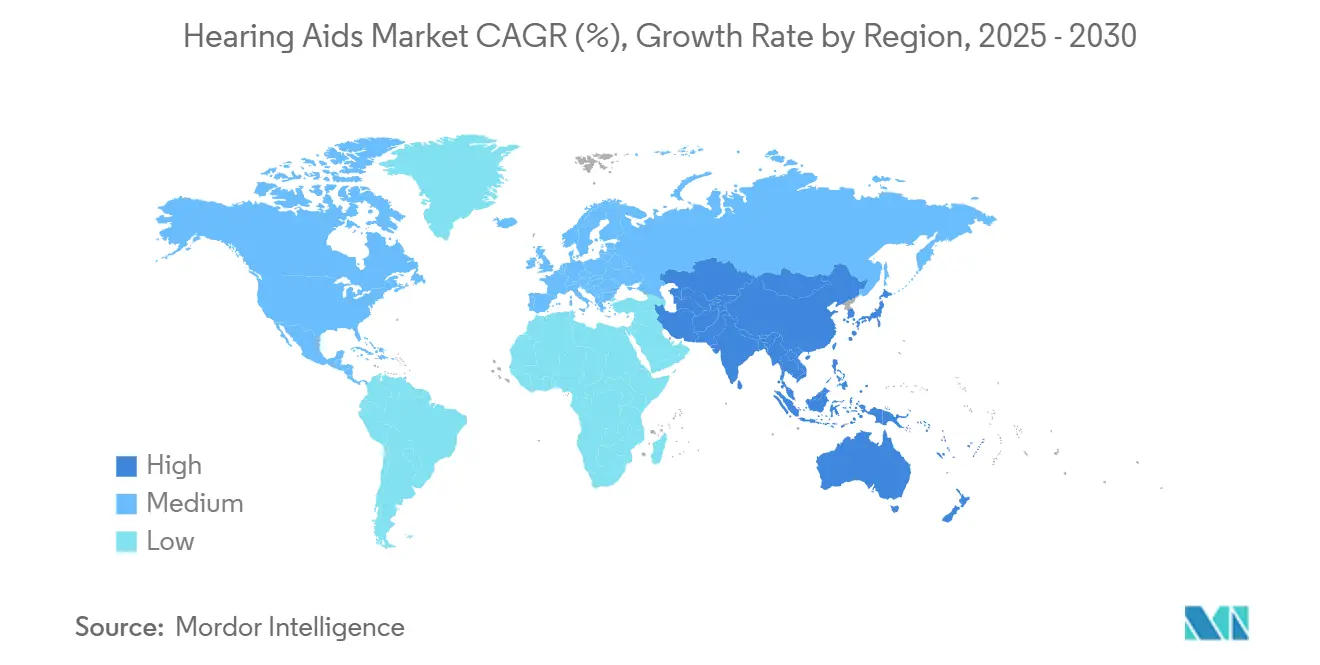
Competitive Landscape
The hearing aids market is moderately concentrated around GN Store Nord and other major companies, which together control signficant global revenue. Vertical integration from R&D to branded retail enables rapid rollout of flagship platforms and firmware updates that keep installed bases current. These leaders invest 6-8% of sales into R&D, with focus on neural processing, energy harvesting and miniaturized antennas.
Convergence with consumer electronics raises competitive heat. Apple leverages its existing earbud franchise to introduce low-cost, software-defined amplification that undercuts traditional ASPs. Bose and Sony pursue similar certification paths, while EssilorLuxottica fuses eyewear and audio through Nuance Audio smart glasses. Such entrants boast strong brand recognition and distribution, forcing incumbents to defend share through concierge-style service and insurance partnerships.
M&A activity underscores the race for scale and technology assets. Eargo’s merger with hearX to form LXE Hearing brings USD 100 million in capital to expand OTC distribution. Demant’s acquisition of GN’s retail chain strengthens its cross-channel presence in Scandinavia. Meanwhile, supply-chain resilience drives dual-sourcing of semiconductors and lithium-ion cells to mitigate geopolitical risk, with manufacturers earmarking 3-5% of revenue for logistics diversification.
Hearing Aids Industry Leaders
-
Audina Hearing Instruments, Inc.
-
Amplifon SpA
-
Cochlear Ltd
-
Horentek Hearing Diagnostics
-
GN Store Nord A/S
- *Disclaimer: Major Players sorted in no particular order
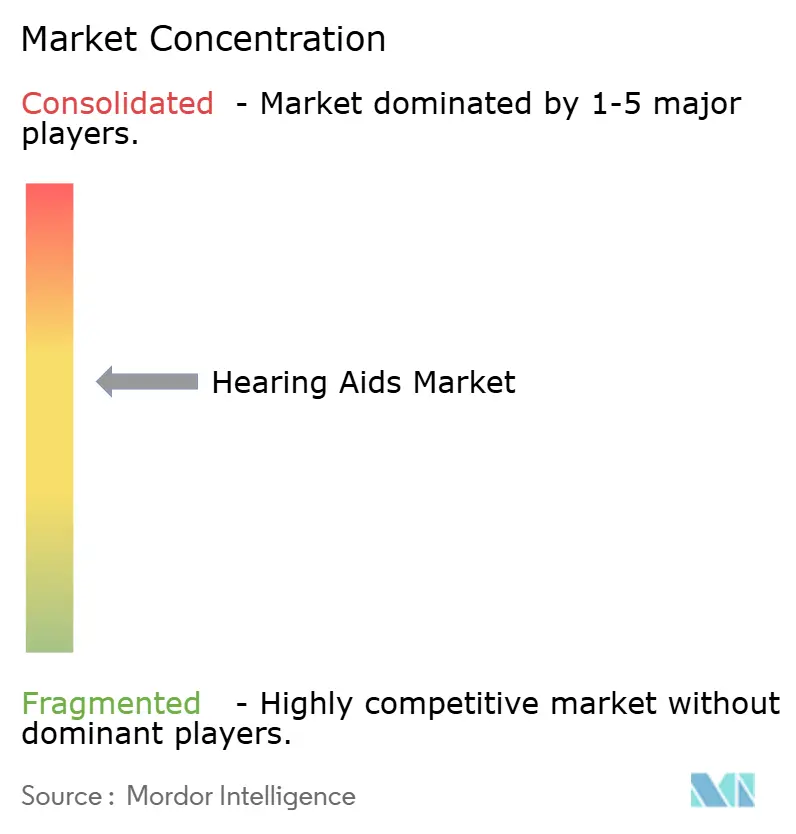
Recent Industry Developments
- February 2025: Signia launched Pure Charge&Go BCT IX offering Bluetooth Classic connectivity, 36-hour battery life and Real-Time Conversation Enhancement.
- February 2025: GN Store Nord introduced ReSound Vivia with AI-powered neural processing and Bluetooth LE Audio support in the United States and Germany.
- February 2025: Beltone unveiled Envision aids featuring AI noise management and Auracast streaming, available from February 20 2025.
Research Methodology Framework and Report Scope
Market Definitions and Key Coverage
Our study defines the global hearing aids market as the sale of medically regulated, externally worn or implantable devices that amplify sound to compensate for mild to profound hearing loss across all age groups. According to Mordor Intelligence, the scope spans behind-the-ear, receiver-in-canal, in-the-ear, completely-in-canal, and implantable solutions powered by analog, digital, or AI-enabled signal processing.
Scope exclusion: personal sound amplification products (PSAPs) and purely diagnostic audiology equipment are not counted.
Segmentation Overview
- By Product Type
- Behind-the-Ear (BTE)
- Receiver-in-Canal (RIC) / Receiver-in-Ear (RITE)
- In-the-Ear (ITE)
- Completely-in-Canal (CIC)
- Implantable (Cochlear, Bone-anchored)
- Other Hearing Aids
- By Technology
- Conventional Analog
- Digital
- AI-enabled / Smart
- By Type of Hearing Loss
- Sensorineural
- Conductive
- Mixed
- Single-sided Deafness
- By Patient Type
- Adults
- Pediatrics / Children
- By Distribution Channel
- Prescription (Hearing-care professionals)
- OTC Retail Pharmacies
- Online Direct-to-Consumer
- Hybrid Tele-audiology
- By Device Design
- Disposable Battery
- Rechargeable Lithium-ion
- Energy-harvesting / Solar
- Geography
- North America
- United States
- Canada
- Mexico
- Europe
- Germany
- United Kingdom
- France
- Italy
- Spain
- Rest of Europe
- Asia-Pacific
- China
- Japan
- India
- South Korea
- Australia
- Rest of Asia-Pacific
- Middle East and Africa
- GCC
- South Africa
- Rest of Middle East and Africa
- South America
- Brazil
- Argentina
- Rest of South America
- North America
Detailed Research Methodology and Data Validation
Primary Research
Mordor analysts conducted interviews with audiologists, ENT surgeons, and buying groups across North America, Europe, and Asia-Pacific. Practitioner feedback on device mix shifts toward rechargeable BTE models and on early uptake of over-the-counter (OTC) pathways filled gaps left by secondary datasets and guided assumption fine tuning.
Desk Research
We began with structured desk research that mined open-access repositories such as WHO Global Health Observatory, National Institute on Deafness and Other Communication Disorders, EuroTrak household surveys, UN Comtrade shipment codes for 9021.40 devices, and filings submitted to the US FDA 510(k) database. Financial disclosures, investor decks, and quarterly volumes from the five largest hearing aid manufacturers anchored average selling price (ASP) trends. Select proprietary feeds, D&B Hoovers for company revenue splits and Dow Jones Factiva for press flow, helped trace channel expansion and policy changes. The data sources mentioned illustrate the evidence base; numerous additional references informed validation and clarification.
Market-Sizing & Forecasting
A top-down incidence to treatment pool reconstruction starts with age-stratified prevalence of hearing impairment, which is then linked to device adoption ratios and region-specific replacement cycles. Supplier roll-ups and sampled ASP × unit checks provide bottom-up reasonableness tests before numbers are locked. Key variables include geriatric population growth, digital BTE penetration, ASP compression from OTC entrants, reimbursement policy shifts, and implant adoption momentum. Forecasts to 2030 deploy multivariate regression that weights those drivers against historical shipment elasticity; scenarios validated with expert panels adjust for sudden regulatory or macro shocks.
Data Validation & Update Cycle
Outputs undergo variance checks versus customs values, manufacturer shipment disclosures, and insurance reimbursement tallies. An analyst review panel flags anomalies, and any material event triggers an interim refresh. The full dataset is updated annually so clients receive the most current baseline before delivery.
Why Mordor Hearing Aids Baseline Commands Decision Maker Confidence
Published estimates differ because firms choose varying product mixes, pricing assumptions, and refresh cadences.
Key gap drivers include whether OTC units are folded into totals, how ASP erosion from rechargeable adoption is modeled, the blend of analog versus digital devices, and the frequency of model revisions.
Benchmark comparison
| Market Size | Anonymized source | Primary gap driver |
|---|---|---|
| USD 10.12 B (2025) | Mordor Intelligence | - |
| USD 13.97 B (2024) | Global Consultancy A | Includes PSAPs and uses list prices without regional ASP adjustments |
| USD 9.74 B (2024) | Regional Consultancy B | Excludes implantables and assumes static replacement interval |
| USD 8.48 B (2024) | Industry Journal C | Relies on 2023 shipment base and applies flat growth multiplier |
These comparisons show that our disciplined scope definition, dual-path modeling, and yearly refresh deliver a balanced, transparent baseline that decision makers can readily trace back to clear variables and repeatable steps.
Key Questions Answered in the Report
What is the current size of the hearing aids market and how fast is it growing?
The market is valued at USD 10.12 billion in 2025 and is forecast to rise to USD 12.87 billion by 2030 at a 4.94% CAGR.
Which product category holds the largest revenue share today?
Behind-the-Ear devices lead with 45.35% of global revenue in 2024.
What region is expected to record the fastest expansion through 2030?
Asia-Pacific is projected to advance at an 8.21% CAGR, outpacing all other regions.
How are over-the-counter (OTC) regulations affecting distribution models?
U.S. OTC legalization is spurring a 9.21% CAGR for retail pharmacies and e-commerce channels while compressing traditional audiology margins.
What role do rechargeable batteries play in user adoption?
Rechargeable lithium-ion models now make up 80% of U.S. unit sales and are growing globally at 10.21% CAGR thanks to longer runtime and convenience.
Page last updated on:
